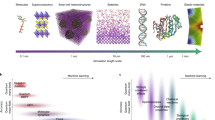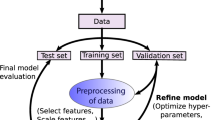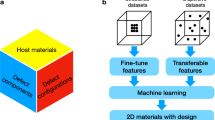Abstract
Natural and manufactured materials rely on complex hierarchical microstructures to deliver a suite of interesting properties. To predict and tailor their performance requires a joined-up knowledge of their multiphase microstructure, interfaces, chemistry and crystallography from the nanoscale to the macroscale. This Perspective reflects on how recent developments in correlative characterization can bring together multiple image modalities and maps of the local chemistry, structure and functionality to form rich multimodal and multiscale correlated datasets. The automated collection and digitization of multidimensional data is an essential part of the picture for developing multiscale modelling and ‘big data’-driven machine learning approaches. These are needed to both improve our understanding of existing materials and exploit high-throughput combinatorial synthesis, processing and testing methods to develop materials with bespoke properties.
This is a preview of subscription content, access via your institution
Access options
Access Nature and 54 other Nature Portfolio journals
Get Nature+, our best-value online-access subscription
$29.99 / 30 days
cancel any time
Subscribe to this journal
Receive 12 print issues and online access
$259.00 per year
only $21.58 per issue
Buy this article
- Purchase on Springer Link
- Instant access to full article PDF
Prices may be subject to local taxes which are calculated during checkout





Similar content being viewed by others
References
Ando, T. et al. The 2018 correlative microscopy techniques roadmap. J. Phys. D 51, 443001 (2018).
Sankaran, K. K. & Mishra, R. S. in Metallurgy and Design of Alloys with Hierarchical Microstructures (eds Sankaran, K. K. & Mishra, R. S.) 21–41 (Elsevier, 2017).
Liu, Y. M. & Zhang, X. Metamaterials: a new frontier of science and technology. Chem. Soc. Rev. 40, 2494–2507 (2011).
Zimmermann, E. A., Barth, H. D. & Ritchie, R. O. The multiscale origins of fracture resistance in human bone and its biological degradation. JOM 64, 486–493 (2012).
Daly, M. et al. A multi-scale correlative investigation of ductile fracture. Acta Mater. 130, 56–68 (2017).
Starborg, T. et al. Experimental steering of electron microscopy studies using prior X-ray computed tomography. Ultramicroscopy 201, 58–67 (2019).
Overwijk, M. H. F., Vandenheuvel, F. C. & Bullelieuwma, C. W. T. Novel scheme for the preparation of transmission electron-microscopy specimens with a focused ion-beam. J. Vac. Sci. Technol. B 11, 2021–2024 (1993).
Echlin, M. P., Mottura, A., Torbet, C. J. & Pollock, T. M. A new TriBeam system for three-dimensional multimodal materials analysis. Rev. Sci. Instr. 83, 023701 (2012).
Jiruše, J. et al. Combined plasma FIB-SEM. Microsc. Microanal. 18, 652–653 (2012).
Burnett, T. L. et al. Large volume serial sectioning tomography by Xe plasma FIB dual beam microscopy. Ultramicroscopy 161, 119–129 (2016).
Hayworth, K. J. et al. Imaging ATUM ultrathin section libraries with WaferMapper: A multi-scale approach to EM reconstruction of neural circuits. Front. Neural Circ. 8, 68 (2014).
Eberle, A. L., Selchow, O., Thaler, M., Zeidler, D. & Kirmse, R. Mission (im)possible – mapping the brain becomes a reality. Microscopy 64, 45–55 (2015).
Xue, D. et al. Accelerated search for materials with targeted properties by adaptive design. Nat. Commun. 7, 11241 (2016).
Shu, X. et al. A genetically encoded tag for correlated light and electron microscopy of intact cells, tissues, and organisms. PLoS Biology 9, e1001041 (2011).
de Boer, P., Hoogenboom, J. P. & Giepmans, B. N. G. Correlated light and electron microscopy: ultrastructure lights up! Nat. Meth. 12, 503–513 (2015).
Herbig, M. et al. Atomic-scale quantification of grain boundary segregation in nanocrystalline material. Phys. Rev. Lett. 112, 126103 (2014).
Robertson, I. M. et al. Towards an integrated materials characterization toolbox. J. Mater. Res. 26, 1341–1383 (2011).
Judenhofer, M. S. et al. Simultaneous PET-MRI: a new approach for functional and morphological imaging. Nat. Med. 14, 459–465 (2008).
McDonald, S. A. et al. Microstructural evolution during sintering of copper particles studied by laboratory diffraction contrast tomography (LabDCT). Sci. Rep. 7, 5251 (2017).
Winiarski, B. et al. Broad ion beam serial section tomography. Ultramicroscopy 172, 52–64 (2017).
Karnowski, K. et al. Optical coherence microscopy as a novel, non-invasive method for the 4D live imaging of early mammalian embryos. Sci. Rep. 7, 4165 (2017).
Garcea, S. C., Wang, Y. & Withers, P. J. X-ray computed tomography of polymer composites. Compos. Sci. Technol. 156, 305–319 (2018).
Withers, P. J. & Preuss, M. Fatigue and damage in structural materials studied by x-ray tomography. Annu. Rev. Mater. Res. 42, 81–103 (2012).
Robinson, J. B. et al. Non-uniform temperature distribution in Li-ion batteries during discharge – a combined thermal imaging, X-ray micro-tomography and electrochemical impedance approach. J. Power Sources 252, 51–57 (2014).
Bay, B. K., Smith, T. S., Fyhrie, D. P. & Saad, M. Digital volume correlation: three-dimensional strain mapping using X-ray tomography. Exp. Mech. 39, 217–226 (1999).
Franck, C., Hong, S., Maskarinec, S. A., Tirrell, D. A. & Ravichandran, G. Three-dimensional full-field measurements of large deformations in soft materials using confocal microscopy and digital volume correlation. Exp. Mech. 47, 427–438 (2007).
Eastwood, D. S. et al. Lithiation induced dilation mapping in a Li-ion battery electrode by 3D X-ray microscopy and digital volume correlation. Adv. Energy Mater. 4, 1300506 (2014).
Jones, R. H. & Simonen, E. P. Early stages in the development of stress-corrosion cracks. Mater. Sci. Eng. A 176, 211–218 (1994).
Turnbull, A., McCartney, L. N. & Zhou, S. A model to predict the evolution of pitting corrosion and the pit-to-crack transition incorporating statistically distributed input parameters. Corros. Sci. 48, 2084–2105 (2006).
Tammas-Williams, S., Withers, P. J., Todd, I. & Prangnell, P. B. The influence of porosity on fatigue crack initiation in additively manufactured titanium components. Sci. Rep. 7, 7308 (2017).
Burnett, T. L. et al. The role of crack branching in stress corrosion cracking of aluminium alloys. Corros. Rev. 33, 443–454 (2015).
Horner, D. A., Connolly, B. J., Zhou, S., Crocker, L. & Turnbull, A. Novel images of the evolution of stress corrosion cracks from corrosion pits. Corros. Sci. 53, 3466–3485 (2011).
Stannard, T., BaleJeff, H., Merkle, A., Lauridsen, E. & Chawla, N. in 3rd International Conference on Tomography of Materials and Structures (ICTMS, 2017).
Handschuh, S., Baeumler, N., Schwaha, T. & Ruthensteiner, B. A correlative approach for combining microCT, light and transmission electron microscopy in a single 3D scenario. Front. Zool. 10, 44 (2013).
Paul-Gilloteaux, P. et al. eC-CLEM: flexible multidimensional registration software for correlative microscopies. Nat. Meth. 14, 102–103 (2017).
Fuentes-Pacheco, J., Ruiz-Ascencio, J. & Rendon-Mancha, J. M. Visual simultaneous localization and mapping: a survey. Artif. Intell. Rev. 43, 55–81 (2015).
Slater, T. J. A. et al. Correlating catalytic activity of Ag-Au nanoparticles with 3D compositional variations. Nano Lett. 14, 1921–1926 (2014).
Jacques, S. D. M. et al. A laboratory system for element specific hyperspectral X-ray imaging. Analyst 138, 755–759 (2013).
Cumpson, P. J., Fletcher, I. W., Sano, N. & Barlow, A. J. Rapid multivariate analysis of 3D ToF-SIMS data: graphical processor units (GPUs) and low-discrepancy subsampling for large-scale principal component analysis. Surf. Interface Anal. 48, 1328–1336 (2016).
Fu, X. et al. Non-destructive mapping of grains in three dimensions. Scr. Mater. 49, 1093–1096 (2003).
Calcagnotto, M., Ponge, D., Demir, E. & Raabe, D. Orientation gradients and geometrically necessary dislocations in ultrafine grained dual-phase steels studied by 2D and 3D EBSD. Mater. Sci. Eng. A 527, 2738–2746 (2010).
Kelly, M. N., Glowinski, K., Nuhfer, N. T. & Rohrer, G. S. The five parameter grain boundary character distribution of alpha-Ti determined from three-dimensional orientation data. Acta Mater. 111, 22–30 (2016).
Toda, H. et al. In situ observation of ductile fracture using X-ray tomography technique. Acta Mater. 59, 1995–2008 (2011).
Liao, H. G. et al. Facet development during platinum nanocube growth. Science 345, 916–919 (2014).
Groeber, M. A. & Jackson, M. A. DREAM.3D: A digital representation environment for the analysis of microstructure in 3D. Integr. Mater. Manuf. Innov. 3, 5 (2014).
Yeratapally, S. R., Glavicic, M. G., Hardy, M. & Sangid, M. D. Microstructure based fatigue life prediction framework for polycrystalline nickel-base superalloys with emphasis on the role played by twin boundaries in crack initiation. Acta Mater. 107, 152–167 (2016).
Kalinin, S. V., Sumpter, B. G. & Archibald, R. K. Big-deep-smart data in imaging for guiding materials design. Nature Materials 14, 973–980 (2015).
Young, T. J. et al. The use of the PeakForce quantitative nanomechanical mapping AFM-based method for high-resolution Young’s modulus measurement of polymers. Meas. Sci. Technol. 22, 125703 (2011).
Reichardt, A. et al. In situ micro tensile testing of He+2 ion irradiated and implanted single crystal nickel film. Acta Mater. 100, 147–154 (2015).
Gianola, D. S. & Eberl, C. Micro- and nanoscale tensile testing of materials. JOM 61, 24 (2009).
Meirer, F. et al. Three-dimensional imaging of chemical phase transformations at the nanoscale with full-field transmission X-ray microscopy. J. Synchrotron. Radiat. 18, 773–781 (2011).
Allison, J., Backman, D. & Christodoulou, L. Integrated computational materials engineering: a new paradigm for the global materials profession. JOM 58, 25–27 (2006).
Glaessgen, E. H. & Stargel, D. S. in 53rd Structures, Structural Dynamics, and Materials Conference (AIAA, 2012).
Council, N. R. Integrated Computational Materials Engineering: A Transformational Discipline for Improved Competitiveness and National Security (The National Academies Press, 2008).
Jain, A. et al. Commentary: The Materials Project: A materials genome approach to accelerating materials innovation. APL Mater. 1, 011002 (2013).
Christodoulou, J. A. Integrated computational materials engineering and materials genome initiative: accelerating materials innovation. Adv. Mater. Proc. 171, 28–31 (2013).
Panchal, J. H., Kalidindi, S. R. & McDowell, D. L. Key computational modeling issues in integrated computational materials engineering. Comput. Aided Des. 45, 4–25 (2013).
Ramakrishna, S. et al. Materials informatics. J. Intell. Manuf. https://doi.org/10.1007/s10845-018-1392-0 (2018).
Agrawal, A. & Choudhary, A. Perspective: materials informatics and big data: realization of the “fourth paradigm” of science in materials science. APL Mater. 4, 053208 (2016).
Takeuchi, I., Lauterbach, J. & Fasolka, M. J. Combinatorial materials synthesis. Mater. Today 8, 18–26 (2005). October.
Alberi, K. et al. The 2019 materials by design roadmap. J. Phys. D 52, 1 (2019).
Springer, H. & Raabe, D. Rapid alloy prototyping: compositional and thermo-mechanical high throughput bulk combinatorial design of structural materials based on the example of 30Mn–1.2C–xAl triplex steels. Acta Mater. 60, 4950–4959 (2012).
Hardwick, D. & Williams, W. M. The birth of metallography – the work of Henry Clifton Sorby (1826–1908). Bull. Canad. Instit. Mining Metallurgy 73, 143–144 (1980).
Wodo, O., Broderick, S. & Rajan, K. Microstructural informatics for accelerating the discovery of processing-microstructure-property relationships. MRS Bull. 41, 603–609 (2016).
Schmitz, G. J. et al. Towards a metadata scheme for the description of materials – the description of microstructures. Sci. Technol. Adv. Mater. 17, 410–430 (2016).
DeCost, B. L. & Holm, E. A. A computer vision approach for automated analysis and classification of microstructural image data. Comput. Mater. Sci. 110, 126–133 (2015).
McDowell, D. L. & LeSar, R. A. The need for microstructure informatics in process-structure-property relations. MRS Bull. 41, 587–593 (2016).
Kalidindi, S. R. Hierarchical Materials Informatics (Butterworth-Heinemann, 2015).
Speed, J. The Theatre of the Empire of Great Britain, Presenting An Exact Geography Of England, Scotland, Ireland, Etc.: Together with a Prospect of the Most Famous Parts of the World (Bassett & Chiswell, 1676).
Ogilby, J. Britannia Depicta: Or, Ogilby Improv’d. Being an Actual Survey of All the Direct and Principal Cross Roads in England and Wales (Bowles, 1764).
Burnett, T. L. et al. Correlative tomography. Sci. Rep. 4, 4711 (2014).
Arnoux, G. et al. Power handling of the JET ITER-like wall. Physica Scripta 2014, 014009 (2014).
Leonard, K. J., Gussev, M. N., Stevens, J. N. & Busby, J. T. Analysis of stress corrosion cracking in alloy 718 following commercial reactor exposure. J. Nucl. Mater. 466, 443–459 (2015).
Chimi, Y. et al. Correlation between locally deformed structure and oxide film properties in austenitic stainless steel irradiated with neutrons. J. Nucl. Mater. 475, 71–80 (2016).
Griffiths, M. A review of microstructure evolution in zirconium alloys during irradiation. J. Nucl. Mater. 159, 190–218 (1988).
Dagan, M. et al. Imaging of radiation damage using complementary field ion microscopy and atom probe tomography. Ultramicroscopy 159, 387–394 (2015).
Gilbert, M. R. et al. Neutron-induced dpa, transmutations, gas production, and helium embrittlement of fusion materials. J. Nucl. Mater. 442, S755–S760 (2013).
Marrow, T. J. et al. Three dimensional observations and modelling of intergranular stress corrosion cracking in austenitic stainless steel. J. Nucl. Mater. 352, 62–74 (2006).
Patra, A. & McDowell, D. L. Crystal plasticity investigation of the microstructural factors influencing dislocation channeling in a model irradiated bcc material. Acta Mater. 110, 364–376 (2016).
Lehtinen, A., Laurson, L., Granberg, F., Nordlund, K. & Alava, M. J. Effects of precipitates and dislocation loops on the yield stress of irradiated iron. Sci. Rep. 8, 6914 (2018).
Marian, J. et al. Recent advances in modeling and simulation of the exposure and response of tungsten to fusion energy conditions. Nucl. Fusion 57, 9 (2017).
Acknowledgements
P.J.W. is grateful to the European Research Council for funding COREL-CT under grant no. 695638. We are grateful for the funding to set up the Henry Moseley X-ray Imaging Facility within the Henry Royce Institute (GR EP/R00661X/1). The Henry Moseley X-ray Imaging Facility was established with funding from the Engineering and Physical Sciences Research Council through grants EP/F007906/1, EP/F001452/1 and EP/I02249X/1. We thank C. Parker for his help on illustrating Figs. 2 and 4. We would also like to thank the Centre of Heritage Imaging and Collection Care and the John Rylands Library at the University of Manchester for their help providing material for Fig. 2.
Author information
Authors and Affiliations
Contributions
Both authors contributed equally to the preparation of this manuscript.
Corresponding author
Ethics declarations
Competing interests
The authors declare no competing interests.
Additional information
Publisher’s note: Springer Nature remains neutral with regard to jurisdictional claims in published maps and institutional affiliations.
Rights and permissions
About this article
Cite this article
Burnett, T.L., Withers, P.J. Completing the picture through correlative characterization. Nat. Mater. 18, 1041–1049 (2019). https://doi.org/10.1038/s41563-019-0402-8
Received:
Accepted:
Published:
Issue Date:
DOI: https://doi.org/10.1038/s41563-019-0402-8
This article is cited by
-
The Extremely Brilliant Source storage ring of the European Synchrotron Radiation Facility
Communications Physics (2023)
-
Cycloidal CT with CNN-based sinogram completion and in-scan generation of training data
Scientific Reports (2022)
-
Inhibiting weld cracking in high-strength aluminium alloys
Nature Communications (2022)
-
Recent Progress of Synchrotron X-Ray Imaging and Diffraction on the Solidification and Deformation Behavior of Metallic Materials
Acta Metallurgica Sinica (English Letters) (2022)
-
High-fidelity and high-resolution phase mapping of granites via confocal Raman imaging
Scientific Reports (2021)



